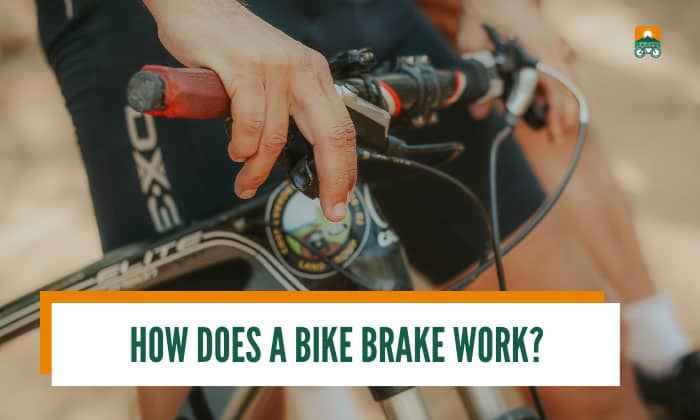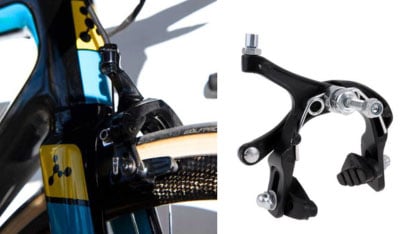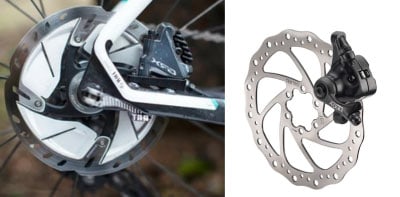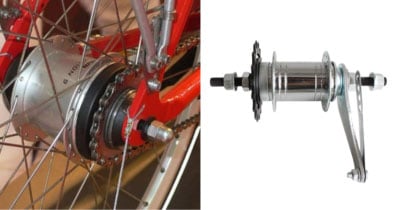Brakes are an important aspect of a bike. However, “How does a bike brake work exactly?”
In simple terms, a bike brake stops your bicycle from turning or slows down your bike. Generally, they work by pressing the hand lever (if your bike has any), and it activates the brakes of your bike.
If you want to know more details, continue reading below to understand how different types of brakes work on a bike and which one is used by your bicycle!
Table of Contents
Different Types of Brakes
A bike brake helps you control the speed of your bike. Some of the different bike brakes are rim brakes, disc brakes, V-brakes, and coaster brakes.
How Does Each Brake Type Work?
These bicycle brake types work differently, as they have certain bike braking systems. We’ll discuss each below so that you can understand how each works and its certain mechanism.
1. Rim Brakes
Bicycle rim brakes utilize hand levers and cables. When the rider pulls the hand levers, each brake pad on each side of the wheel presses against the rim, causing the bike to stop or slow down its speed.
This type of brake has two kinds: caliper brakes and cantilever brakes.
- Caliper Brakes
For a road bike brake, caliper brakes are the most common. When the calipers contract, the brake pads apply pressure to your bike’s rotor, making it stop or slow down.
Caliper brakes have different styles, such as dual-pivot brakes. They are also easy to set up and control.
- Cantilever Brakes
They are commonly used by cyclo-cross bikers. They have two arms that attach to each side of the fork. These brakes have more clearance between brakes and work well in any weather condition, such as on muddy roads.
Pros and cons:
With their simple maintenance, lighter weight, and cheaper price, rim brakes have been popular among cyclists, especially in the past.
Although it has many advantages, rim brakes don’t work well in adverse weather conditions because of the water build-up on the rim’s surface. Due to this, its braking power is also less compared to other brakes, such as disc brakes.
2. V-Brakes
To improve rim brakes, V-Brakes were created. The cable is housed on the brake’s side and runs across the top. When the rider pulls the brake cable, its two long arms are pushed inwards, which causes the brake pads to press against the bike’s rim.
Pros and cons:
V-Brakes are easy to adjust and maintain and cost less than disc brakes. It’s also great for those looking for elevated stability due to its long arms.
Despite its pros, V-Brakes have disadvantages, such as it’s not immune to wet and muddy terrains. In addition, if you compare V-brakes vs disc brakes mountain bikes, the latter has become more popular due to their efficiency and stronger braking power through the use of rotors.
3. Disc Brakes
This type of brake uses rotors and calipers, and their pads are usually hard metallic-based or ceramic-based.
The calipers are attached to the bike’s frame, which houses the braking pads or braking shoes that come into contact with the rotors that stop the bike.
There are also two types of disc brakes for bikes such as mechanical and hydraulic.
- Mechanical disc brakes
This type of disc brake is cable operated, meaning that when the rider pulls the brake, the pads are pushed into the rotor with the help of a cable, which stops your bike.
- Hydraulic disc brakes
Unlike mechanical disc brakes, hydraulic disc brakes use hydraulic fluid to activate the brake. When you brake, hydraulic fluid is released into the caliper, which activates the pads to push into the bike’s rotor.
Of these two types, hydraulic disc brakes are the best option. They don’t have the issue of cable stretching, they’re less maintenance, and all of their braking force is transmitted to the bike, giving it more braking power.
Pros and cons:
Disc brakes are great for an off-road bike such as a mountain bike brake and have more durable brake pads. Also, no matter the weather condition, the stopping power of your dirt bike won’t be affected.
Nevertheless, given their many advantages, disc brakes are heavier and more expensive than other brakes. There’s also a possibility that the rotor will overheat, which may cause it to warp and negatively impact your bicycle’s braking power.
4. Coaster Brakes
Known as backpedal brakes, coaster brakes don’t have cables and hand levers. A coaster brake works by pedaling backward. This way, the brake is activated inside the rear hub, stopping the wheel from rotating.
Pros and cons:
Coaster brakes are great for kids and people who don’t find hand brakes comfortable or easy to use. Also, the braking power isn’t affected by rain because the brakes are found inside the rear hub.
One of the coaster brake problems is skidding, as bicycles that use this brake generally don’t have front brakes. In addition, coaster brakes usually have less braking power compared to other brakes.
Frequently Asked Questions
Can you stop a bike without brakes?
Bikes without brakes exist such as a fixie bike. However, unless you have this kind of bike, stopping without brakes is dangerous because you drag your feet against the ground to do it.
What’s the best bike brake for me?
The best bicycle brake depends on the type of bike you ride and which is more comfortable for you. For example, if you’re riding a mountain bike, disc brakes are ideal due to their efficient and powerful braking.
Conclusion
Bicycle brakes work by using friction and pressure to stop your bicycle. There are different types of brakes depending on your preference and the kind of bike you ride. For instance, there are rim brakes, disc brakes, V-brakes, and coaster brakes.
Now that you know the answer to this question, “How does a bike brake work?”, we hope you now understand brake systems and mechanisms better. Just make sure you know when to use your bike brakes to ensure your safety on the trails and roads!

“I ride my bike to work for years, but is that enough? Our carelessness towards our surroundings has taken a toll on the environment. And now, everyone is responsible for changes; even the most minor contribution is counted. With this hope and spirit, I started with my partner to establish Biketoworkday to help more individuals commute to their work sites on their bikes.”







